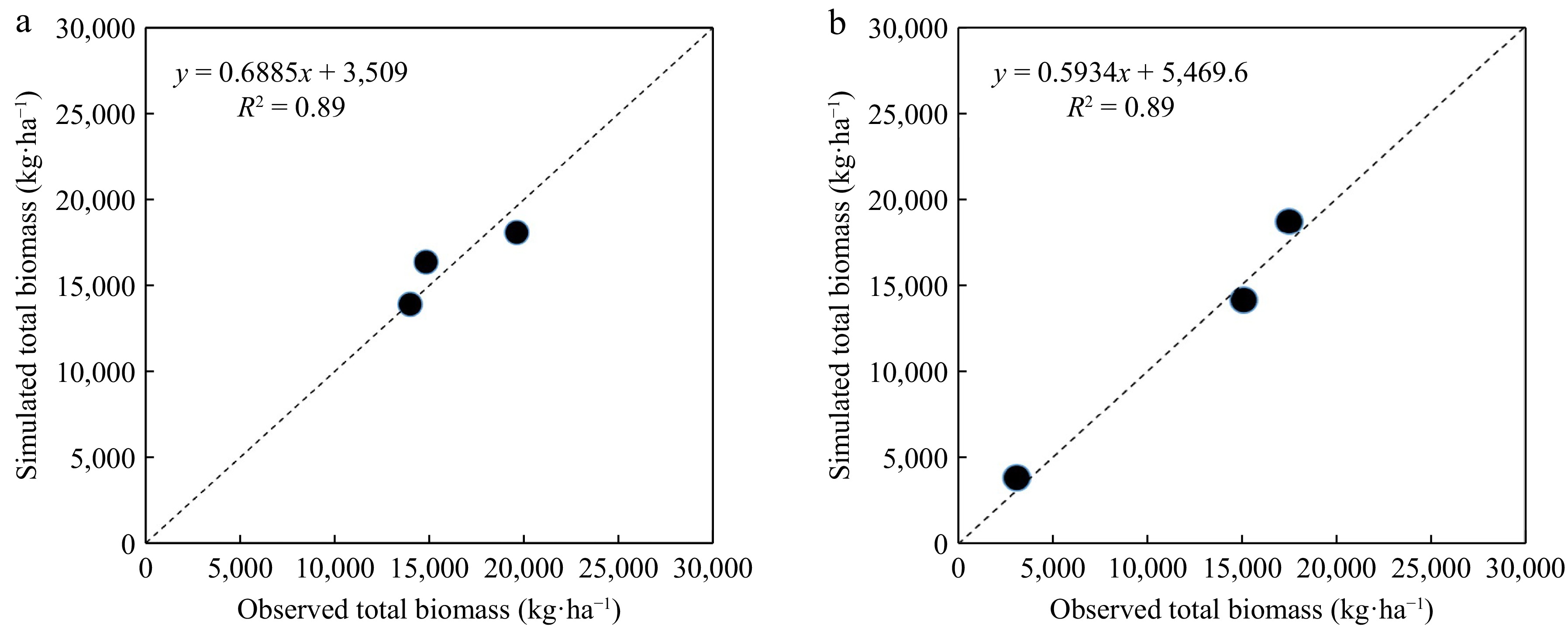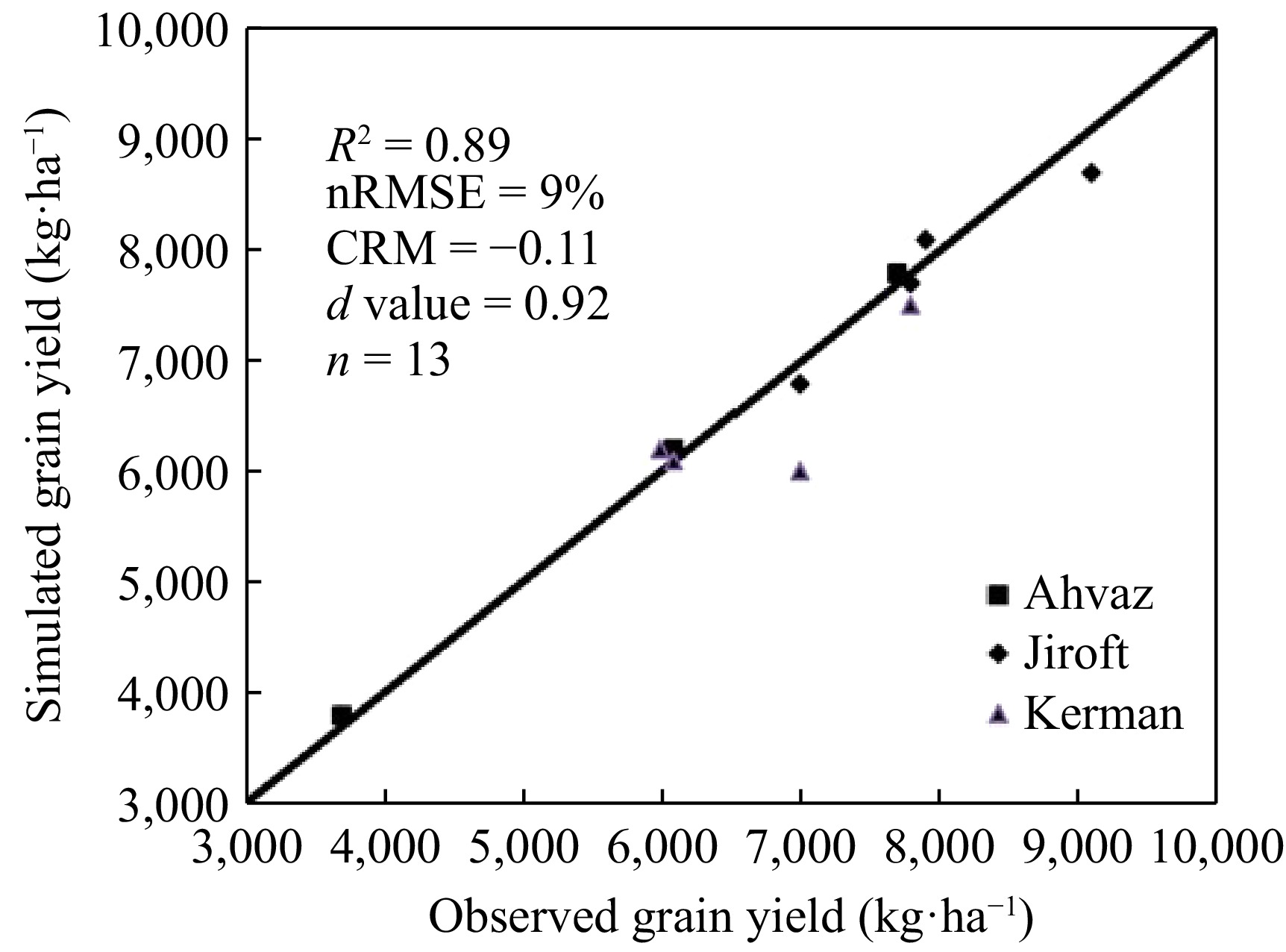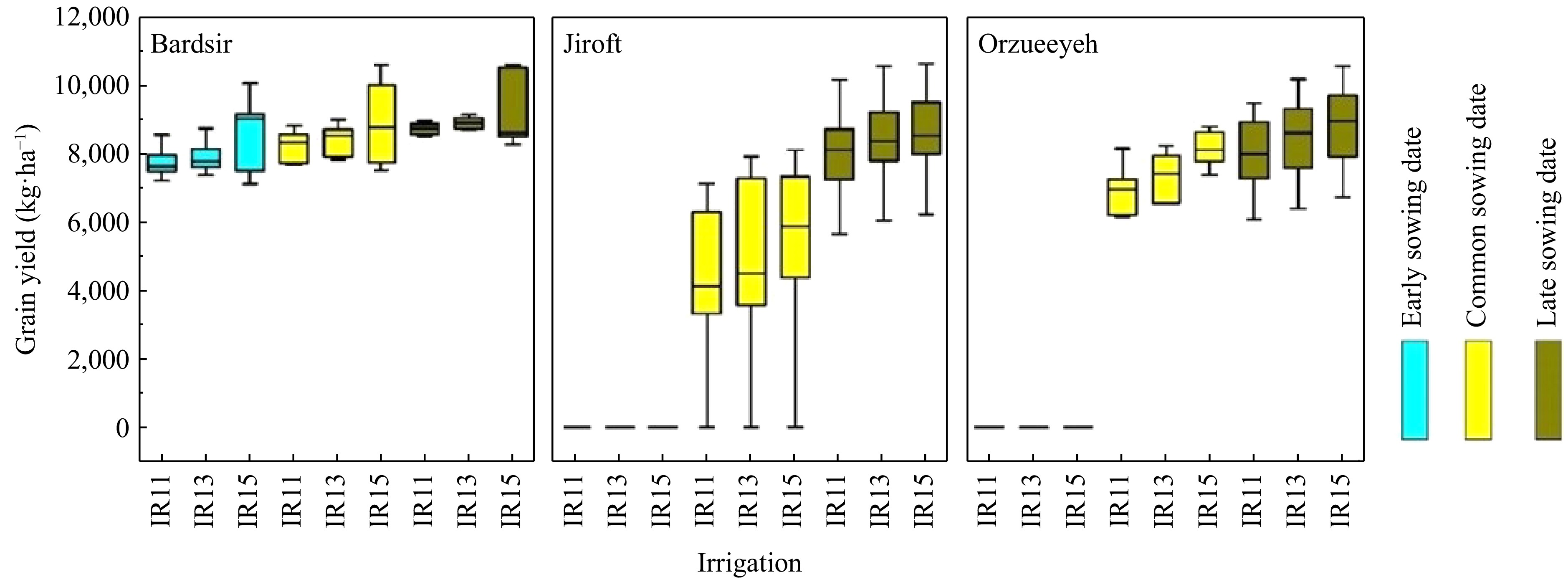-

Figure 1.
Comparison of the empirically observed and model-simulated dry matter employing the APSIM framework for the SC704 hybrid cultivar, subjected to varying nitrogen levels (0, 92, and 368 kg·ha−1), was conducted in the years 2020 (a) calibration and 2021 (b) validation.
-

Figure 2.
A comparative analysis of the actual and predicted grain yield utilizing the APSIM model for the SC704 hybrid was conducted under varying nitrogen applications (0, 92, and 368 kg·ha−1) during the year 2020, designated as the calibration year.
-

-

Figure 4.
Grain productivity in relation to various irrigation regimens (IR11: 11 irrigation instances; IR13: 13 irrigation instances; IR15: 15 irrigation instances), planting periods (early, common, and late), as well as the geographical sites examined (Bardsir, Jiroft, and Orzueeyeh). The dimensions of the box plots illustrate the variations in the projected grain yield across different years (2000−2019).
-
Region Longitude Latitude Elevation (m) Mean annual temperature (°C) Mean cumulative precipitation (mm) Bardsir 56.57 29.93 2044 14.5 165 Orzueeyeh 56.36 28.45 1053 23.3 122.3 Jiroft 57.73 28.67 720 25.1 176.2 Table 1.
Climatic and geomorphological attributes of the regions.
-
Attributes Region Bardsir Orzueeyeh Jiroft Soil type Loam sand Loam Loam sand Available soil water (mm) 126 113 115 Bulk density (g·cm−3) 1.4 1.62 1.52 pH 7.9 7.9 8 Electrical conductivity (dS·m−1) 2 1.9 1.2 Organic matter (%) 0.2 0.2 0.2 Nitrate (mg·L−1) 8.2 79.4 73.1 Ammonium (mg·L−1) 2.13 2.26 2.76 Phosphorous (ppm) 4 4 10 Potassium (ppm) 120 180 200 Table 2.
Pedological attributes of the regions.
-
Location Sowing window Number of
irrigationsNitrogen fertilizer
(kg N ha−1)Bardsir 21-Apr 16 276 Orzueeyeh 01-Jul 16 260 Jiroft 21-Jul 16 253 Table 3.
Common sowing window, number of irrigations, and the quantity of nitrogen fertilizer.
-
Parameter Value Unit Maximum number of seeds per head 850 − Thermal time from emergence to juvenile stage 270 °Cd Seed growth rate 8 mg kernel–1 d–1 Thermal time from juvenile phase to floral stage 20 °Cd Critical photoperiod 1 12.5 h Critical photoperiod 2 20 h Table 4.
Parameters determined by adjusting the model calibration for SC704 cultivar.
-
Treatment Calibration (2020) Validation (2021) Observed Simulated Observed Simulated Days from sowing to flowering 0 kg N ha−1 74 69 87 66 92 kg N ha−1 68 69 80 66 368 kg N ha−1 69 69 76 66 nRMSE (%) 2.41 10.17 CRM (−) 0.018 0.185 Days from sowing to maturity 0 kg N ha−1 131 129 135 123 92 kg N ha−1 128 129 134 123 368 kg N ha−1 132 129 136 123 nRMSE (%) 0.95 5.14 CRM (−) 0.01 0.08 Table 5.
Evaluation indices of the APSIM model in simulating days from sowing to flowering and maturity under different nitrogen fertilizer (0, 92, and 368 kg·ha−1) in calibration (2020), and validation (2021) years.
-
Total Calibration (2020) Validation (2021) nRMSE (%) CRM (−) nRMSE (%) CRM (−) Dry matter 13.77 0.19 12.75 −0.18 Grain yield 11.23 0.12 13.21 −0.15 Table 6.
Evaluation parameters of model in simulating total dry matter and grain yield of maize SC704 hybrid under the different quantity of nitrogen (0, 92, and 368 kg·ha−1) for calibration (2020), and validation (2021) years.
-
Region Planting window Average temperature during the growing season (°C) Days to maturity Average maximum temperature for flowering period (°C) Bardsir Common 22.3 142 34.5 Early 22.5 154 33.9 Late 20.7 141 33.9 Orzueeyeh Common 28.7 133 38.9 Early 32.6 129 42.3 Late 22.5 154 34.4 Jiroft Common 28.2 130 38.7 Early 31.8 124 41.3 Late 21.4 154 33.9 Table 7.
Average temperature for growing season, days to maturity, and average maximum temperature for flowering period under different planting windows (common, early, and late) and regions (2000−2019).
Figures
(4)
Tables
(7)